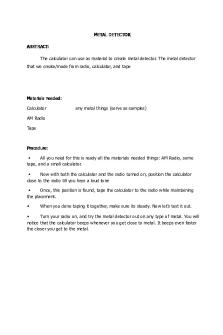Transition metal chemistry summary PDF

| Title | Transition metal chemistry summary |
|---|---|
| Course | Chemistry 2 |
| Institution | University of Melbourne |
| Pages | 10 |
| File Size | 873.9 KB |
| File Type | |
| Total Downloads | 49 |
| Total Views | 127 |
Summary
Download Transition metal chemistry summary PDF
Description
Transition metal chemistry Crystal Field Theory -
-
Describes the bonding in metal complexes Bonding is largely ionic Metal = point positive charge Ligands = point negative charges Electron-electron repulsions effect energies of d orbitals
3d-orbitals in an octahedral arrangement of ligands There are 5 d orbitals In a free ion all of these orbitals would be of the same energy (if there weren’t any ligands around the free ion) – nothing to interact with BUT: Ligand electrons REPEL negatively charged d-electrons Electrons “prefer orbitals” furthest from ligands = lowest energy dxy, dyz and dxz “lowest” energy = t2g set dz2 and dx2-y2 = eg set- enhanced electron repulsion
Changes in energy of d-orbitals in octahedral ‘field’ -
Repulsions: metal d-electrons and electron pairs in ligands Orbitals raised in energy relative to “free” ion Splitting of 3d orbitals = Δ
d-Orbital energies in Oh Field
Crystal Field Stabilisation Energy - (CFSE)
Example:
The -0.4 each time is the -2/5
When moving to the eg orbitals (less stable) you +0.6
CFSE for 2+ transition metal ions changes as you go across the periodic table
-
Remember -ve CFSE means more stable than spherical average
Expected trend in ionic radius
Colour of transition metal complexes
-
Splitting of 3d orbital energies: Colour and magnetism Substances absorb light in visible region of spectrum the colour is determined by wavelengths that remain
Colour of [Ti(H2O)6]3+: 3d1 = violet
Crystal field theory and the colours of metal complexes - Transfer of e- between “split” d-orbitals - Energy (ΔE) of d-orbital splitting corresponds to energies in visible region – energy gap corresponds to the wavelength of visible light
Crystal field splitting in octahedral complexes -
Octahedral complexes Δo in the range 400 - 800 nm In the visible region of the electromagnetic spectrum Colour of complex depends on magnitude of Δo
Changes to coordination sphere change colour -
Changes in ligands change ∆ = change wavelength of absorption
The Crystal Field Model -
Colour and magnetism of complex ions result from changes in the energies of the metal ion d-orbitals caused by metal-ligand interactions CFT Successful in accounting for colour and magnetic properties of transition metal ions Strong field ligands increase the size of delta, and hence increase the energy of absorption
Value of ΔO depends on: -
Metal ion and its oxidation state -> changing oxidation states changes the relative energetics of the d orbitals, changing the d orbital splitting and the absorption. Higher oxidation state = larger ∆ - more electrostatic interactions, smaller the ion, closer the ligands come to the transition metal ion Coordination number and geometry Identity of ligands
-
Ordering of ligands in terms of their ability to split the energies of the metal d-orbitals
High and low spin complexes: For d4 – d7 octahedral
For 4 valence d electrons, d4 - High spin complexes for weak field ligands (halides, water) - Low spin complexes for strong field ligands (NH3, CN-)
Consider octahedral Co3+ complexes
Example Predict the number of unpaired electrons in [Cr(CN)6] 4-
-
Coordination number is 6, octahedral geometry Oxidation state of Cr -> CN- is (-6), overall the compound is -4, so Cr is +2 Cr2+ is d4 , CN- is a strong field ligand, so low spin
Unpaired electrons give rise to para magnetism -
Electrons are charged with spin and orbital angular momentum Moving electric charge -> current -> magnetic field Electrons are a miniature bar magnet, In first row transition metals spin more important than orbital momentum
-
2 electrons of opposite spin - paired(+ ½ or - ½) in an orbital = no magnetic moment = diamagnetic Unpaired electrons in orbital = magnetic moment = paramagnetic
-
Magnetic properties of coordination complexes
Spin only formula -
Depends on number of unpaired electrons per complex
d7 high/low spin
Complexes with a coordination number of 4 -
Two options square planar or tetrahedral The splitting of the d-orbitals is different to the octahedral splitting Square planar:
Tetrahedral:
- Tetrahedral is always high spin – crystal field splitting is opposite to octahedral - For tetrahedral geometry d-orbitals DO NOT point directly at the ligand - Means smaller difference between energy of t2 and e orbitals Example:...
Similar Free PDFs

Transition metal chemistry summary
- 10 Pages

Ekstrusi Metal
- 26 Pages

Transition Words
- 3 Pages

Chemistry Chapter 7 - summary
- 9 Pages

Chemistry Final Summary
- 7 Pages

transition elements
- 24 Pages

Metal Detector
- 1 Pages
Popular Institutions
- Tinajero National High School - Annex
- Politeknik Caltex Riau
- Yokohama City University
- SGT University
- University of Al-Qadisiyah
- Divine Word College of Vigan
- Techniek College Rotterdam
- Universidade de Santiago
- Universiti Teknologi MARA Cawangan Johor Kampus Pasir Gudang
- Poltekkes Kemenkes Yogyakarta
- Baguio City National High School
- Colegio san marcos
- preparatoria uno
- Centro de Bachillerato Tecnológico Industrial y de Servicios No. 107
- Dalian Maritime University
- Quang Trung Secondary School
- Colegio Tecnológico en Informática
- Corporación Regional de Educación Superior
- Grupo CEDVA
- Dar Al Uloom University
- Centro de Estudios Preuniversitarios de la Universidad Nacional de Ingeniería
- 上智大学
- Aakash International School, Nuna Majara
- San Felipe Neri Catholic School
- Kang Chiao International School - New Taipei City
- Misamis Occidental National High School
- Institución Educativa Escuela Normal Juan Ladrilleros
- Kolehiyo ng Pantukan
- Batanes State College
- Instituto Continental
- Sekolah Menengah Kejuruan Kesehatan Kaltara (Tarakan)
- Colegio de La Inmaculada Concepcion - Cebu








